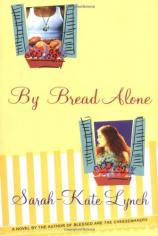Reading Group Guide
Discussion Questions
By Bread Alone

1. At the end of Chapter 1, the stone jar containing the starter-dough for pain au levain is personified when Lynch writes "the stone jar...sat smugly on the floor, its contents quietly bubbling and roiling. You may have given up on me, it whispered into the morning air. But I have not given up on you." The yeast and bacteria in the jar are alive but need to be fed and watered to stay that way. And for anything else to become of that mixture, it needs further feeding, a lot of hands-on attention. In what ways is the starter-dough a metaphor for life? For love? What do we have bubbling away inside all the time? And what can be added to us to increase our potential, make more of our lives?
2. The author 'fleshes out' fully the characterization of Granny Mac. In light of what we later learn about Granny Mac, what is her function in Esme's life at the time we are reading about? Why does she appear when she does? What difference does it make to Esme? Did you think there was something unusual about Granny Mac? Were you surprised to find out just how unusual she was? Many of us have an older person or older people in our lives on whom we call for help and guidance. What can the older generation offer younger ones?
3. In Chapter 2, we first hear about the delightful Jemima Jones, Esme's professional rival. It's years since the two worked together, why does Jemima irritate Esme so? What does Jemima have that Esme doesn't? Is Esme questioning her career and lifestyle choices because of what has happened or would she be doing so anyway? Is it common to wonder how your life might have worked out had you turned a different corner? Is there a Jemima Jones in your life?
4. In Chapter 2, Esme ends her thirty-three-day boycott of breadbaking, and she returns to "that jar of starter, panting in her pantry." Why is this significant? What might have happened to Esme had she not started baking again? What made her more at risk than most? Can unhappiness and its dangerous results run in a family?
5. In Chapter 3, we travel back fifteen years to Esme's first consummated romance in the Lapoine bakery in the Dordogne region of France. Through the fictional technique of a flashback, the author reenacts Esme's nineteenth summer, during which she discovered the ecstasy and agony of first love. How powerful are memories such as these? What can they do for us? Is the memory of first love more vivid than others? Discuss the impact of first loves.
6. In Chapter 16, Esme is sitting in Granny Mac's room and she says about Louis Lapoine: "...he just unlocks something in me that I can't even get to myself, Granny Mac, and I feel like I have to pursue it. After talking to him, you know...about Teddy, I just got this glimpse of what I used to be like and it felt so good I just have to get more of it." What exactly is it that Esme is yearning for? Could Louis ever provide her with this? If not, why not? Could a new relationship, or a rekindled one, ever replace what Esme has lost? To what extent does she blame herself? And who else is doing the same? Is it possible to lead a full and satisfying life if you are harboring blame and suppressing painful memories? If not, why not?
7. At the tender age of four, Rory seems wise beyond his years. Discuss how a small child may be affected by a cataclysmic event. Also look at how Rory, perhaps even more than the adults around him, is able to shed light on his mother's fragile state since the loss of Teddy. Does Rory know about Granny Mac? What does he say to Esme at Alice's flat that might make us suspect he does? How can he and Esme help each other?
8. Pog might not be Esme's first love, but he is her true love. What's the difference? What makes him perfect for her? Is he perfect? What are his flaws? What, if anything, should he have done differently? Is the grass ever greener on the other side of the fence?
By Bread Alone
- Publication Date: October 28, 2004
- Hardcover: 368 pages
- Publisher: Warner Books
- ISBN-10: 0446531294
- ISBN-13: 9780446531290








